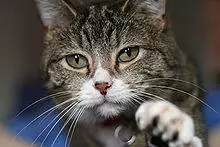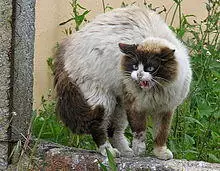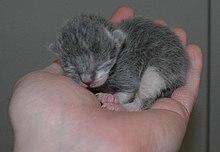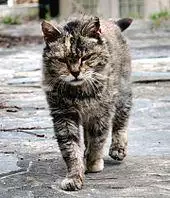cat
The cat (Felis catus) is a domestic species of small carnivorous mammal. It is the only domesticated species in the family Felidae and is often referred to as the domestic cat to distinguish it from the wild members of the family. A cat can either be a house cat, a farm cat or a feral [野的] cat; the latter ranges freely and avoids human contact. Domestic cats are valued by humans for companionship and their ability to hunt rodents. About 60 cat breeds are recognized by various cat registries.
feral; ferocious; fierce
The cat is similar in anatomy to the other felid species: it has a strong flexible body, quick reflexes, sharp teeth and retractable claws adapted to killing small prey. Its night vision and sense of smell are well developed. Cat communication includes vocalizations like meowing [喵喵], purring [呼噜], trilling [颤音], hissing [嘶嘶], growling [狺狺] and grunting [哼哼] as well as cat-specific body language. A predator that is most active at dawn and dusk, the cat is a solitary hunter but a social species. It can hear sounds too faint or too high in frequency for human ears, such as those made by mice and other small mammals. It secretes and perceives pheromones.
felid: a mammal of the cat family (Felidae); a wild cat. 不是field.
Female domestic cats can have kittens from spring to late autumn, with litter sizes often ranging from two to five kittens. Domestic cats are bred and shown at events as registered pedigreed cats, a hobby known as cat fancy. Failure to control breeding of pet cats by spaying and neutering, as well as abandonment of pets, resulted in large numbers of feral cats worldwide, contributing to the extinction of entire bird, mammal, and reptile species, and evoking population [猫口] control.
Cats were first domesticated in the Near East around 7500 BC. It was long thought that cat domestication was initiated in ancient Egypt, as since around 3100 BC veneration was given to cats in ancient Egypt. As of 2021 there are an estimated 220 million owned and 480 million stray cats in the world. As of 2017, the domestic cat was the second-most popular pet in the United States, with 95 million cats owned. In the United Kingdom, around 7.3 million cats lived in more than 4.8 million households as of 2019.
The origin of the English word 'cat', Old English catt, is thought to be the Late Latin word cattus, which was first used at the beginning of the 6th century.It was suggested that the word 'cattus' is derived from an Egyptian precursor.
The English puss, extended as pussy and pussycat, is attested from the 16th century and may have been introduced from Dutch poes or from Low German puuskatte, related to Swedish kattepus, or Norwegian pus, pusekatt. The etymology of this word is unknown, but it may have simply arisen from a sound used to attract a cat.
A male cat is called a tom or tomcat (or a gib, if neutered). An unspayed female is called a queen, especially in a cat-breeding context. A juvenile cat is referred to as a kitten. In Early Modern English, the word kitten was interchangeable with the now-obsolete word catling. A group of cats can be referred to as a clowder or a glaring.
The domestic cat has a smaller skull and shorter bones than the European wildcat. It averages about 46 cm (18 in) in head-to-body length and 23–25 cm (9–10 in) in height, with about 30 cm (12 in) long tails. Males are larger than females. Adult domestic cats typically weigh between 4 and 5 kg (9 and 11 lb).
The cat is digitigrade [walking on the toe]. It walks on the toes, with the bones of the feet making up the lower part of the visible leg. Unlike most mammals, it uses a "pacing" gait [步法] and moves both legs on one side of the body before the legs on the other side. It registers [be in proper alignment] directly by placing each hind paw close to the track of the corresponding fore paw, minimizing noise and visible tracks. This also provides sure footing for hind paws when navigating rough terrain. As it speeds up walking to trotting, its gait changes to a "diagonal" gait: The diagonally opposite hind and fore legs move simultaneously.
digit: 数字; 手指;脚趾,显然当初人们是扳指头数数的。
Cats have protractable and retractable claws. In their normal, relaxed position, the claws are sheathed with the skin and fur around the paw's toe pads. This keeps the claws sharp by preventing wear from contact with the ground and allows the silent stalking of prey. The claws on the fore feet are typically sharper than those on the hind feet. Cats can voluntarily extend their claws on one or more paws. They may extend their claws in hunting or self-defense, climbing, kneading, or for extra traction on soft surfaces. Cats shed the outside layer of their claw sheaths when scratching rough surfaces. Most cats have five claws on their front paws, and four on their rear paws.
Cats have excellent night vision and can see at only one-sixth the light level required for human vision.
The domestic cat's hearing is most acute in the range of 500 Hz to 32 kHz. It can detect an extremely broad range of frequencies ranging from 55 Hz to 79,000 Hz. It can hear a range of 10.5 octaves, while humans and dogs can hear ranges of about 9 octaves. Its hearing sensitivity is enhanced by its large movable outer ears, the pinnae, which amplify sounds and help detect the location of a noise. It can detect ultrasound, which enables it to detect ultrasonic calls made by rodent prey.
Cats have an acute sense of smell, due in part to their well-developed olfactory bulb [嗅球] and a large surface of olfactory mucosa [嗅粘膜], about 5.8 square centimetres in area [面积], which is about twice that of humans.
Cats have relatively few taste buds compared to humans (470 or so versus more than 9,000 on the human tongue).
To aid with navigation and sensation, cats have dozens of movable whiskers (vibrissae) over their body, especially their faces. These provide information on the width of gaps and on the location of objects in the dark, both by touching objects directly and by sensing air currents; they also trigger protective blink reflexes to protect the eyes from damage.
Most breeds of cat have a noted fondness for sitting in high places, or perching. A higher place may serve as a concealed site from which to hunt; domestic cats strike prey by pouncing from a perch such as a tree branch.
Cats are known for spending considerable amounts of time licking their coats to keep them clean.
六级/考研单词: mammal, seldom, latter, hunt, fierce, rigid, paw, prey, dawn, dusk, solitary, faint, autumn, litter, pastime, pet, abandon, extinct, evoke, initiate, million, stray, unite, derive, juvenile, glare, skull, weigh, correspond, navigate, terrain, simultaneous, digit, norm, fur, pad, stalk, volunteer, shed, scratch, rear, superb, acute, detect, outer, amplify, bulb, centimetre, bud, versus, sensation, trigger, blink, fond, perch, conceal, lick








 浙公网安备 33010602011771号
浙公网安备 33010602011771号